On this page
- Research article
- Volume 44, Issue 1
- Pages: 39
- -49
- Open Access
- Download
Construction and Practice of Higher Vocational Innovation and Entrepreneurship Practice and Training Mode Based on Internet +
- Published: 29/12/2023
Abstract
“Internet+” is a new model of social development in the innovation 2.0 era. It basically effectively combines traditional industries with the Internet, injects new innovation impetus into traditional enterprises, and improves the quality and efficiency of enterprise transformation. In the “Internet+” era, the innovation and entrepreneurship of student education should be realized by referring to the successful cases of foreign universities. All teaching contents should be adapted to the needs of students as far as possible, and innovation should be realized in the educational model taking into account the social reality. Cultivate innovative and entrepreneurial talents in line with social needs. This paper discusses the impact of “Internet+” on the teaching of innovation and entrepreneurship education courses for college students, analyzes the problems existing in the teaching model of “Internet+” innovation and entrepreneurship courses for college students, and puts forward optimization measures. The purpose is to provide reference and reference for promoting the reform, innovation and development of college students’ innovation and entrepreneurship curriculum.
- Keywords: "Internet +", college students, innovation and entrepreneurship education (I&E education), federal learning(FL)
Copyright © 2023 Ling Tang and Xuemei Zeng. This is an open access article distributed under the Creative Commons Attribution License, which permits unrestricted use, distribution, and reproduction in any medium, provided the original work is properly cited.
1. Introduction
In China, scholars began to pay attention to and study sports tourism in coastal, island and beach sites since 2002, and the scope of research was mostly concentrated and lim-ited to some provinces and cities such as Students’ I&E courses are very comprehensive [1]. In order to make them more effective, we must strive to innovate and play a more active role in the I&E learning mode of college students [2]. In the context of the effective integration of “Internet+” and various industries, we should attach great importance to building a “Internet+” learning model for college students’ I&E education projects. Only in this way can we teach students I&E education courses more effectively [3]. From the overall situation of students’ I&E education project teaching, although the application of “Internet+” has received certain attention and achieved certain results, it conforms to higher standards and requirements. The teaching model of college students’ I&E courses still has many defects, limiting the teaching development of college students’ I&E courses at the level of “Internet+”. However, under the high standards and requirements, there are still many aspects that have not been established, which limits the in-depth teaching of college students’ I&E courses and needs attention [4].
The effective combination of “Internet+” and college students’ I&E education project teaching will help further optimize the teaching system, and further enrich the learning resources [5]. In this process, especially the establishment of the network platform for the college students’ I&E training class, forming a better working mechanism and management model. Since teaching I&E education courses for students is also practical, the “Internet+” application can also achieve a breakthrough in “practical education” in teaching I&E education courses for college students [6].
“Internet+” refers to connecting the Internet to different industries, in the new environment, it provided students with an innovative technology platform that can not be realized by in-depth learning and traditional learning [7–8]. In the “Internet+” I&E activities, students from local universities and key colleges stand at a new starting line, face new opportunities together, share business opportunities, and contribute to the development and embodiment of personal advantages. However, emerging industries require students to constantly cultivate innovative awareness and entrepreneurial thinking, and improve their professional level and application ability based on the Internet [9–10].
In short, “Internet+” has a strong openness, integration and interaction. Its application in the teaching of I&E education courses is of great significance. It can fundamentally change the teaching mode. In particular, by building an “online” operation mode, it can fundamentally change the teaching mode of I&E courses for college students. In particular, establish an operation mode combining “online” and “offline”. This will help improve the effectiveness of I&E courses [11]. We should pay attention to the innovative teaching concept of I&E course, the innovative teaching method of I&E course and the innovative “three innovations” in I&E course teaching to encourage I&E education plan, so as to achieve new and higher achievements. Teaching innovative education programs to students will achieve new and greater results.
2. Related Works
This article uses the Chinese knowledge network system to search statistics, and directly searches for more than 17000 documents with the keyword “college students’ I&E”[5-7]. This paper sets the keywords of “Internet+” and “I&E education”, and searches more than 1900 articles related to “Internet+” and “I&E education”, reaching the peak in 2018, and entering a period of high research achievements in 2021. The overall trend is analyzed in Figure 1 and 2.
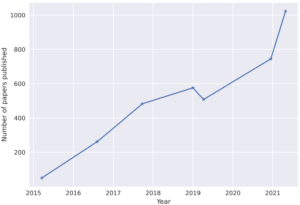
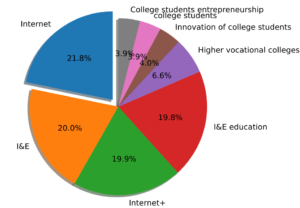
Overseas research is early, and there are successful experiences in education concept, discipline construction, internal and external environment and operation mechanism [12]. An effective “entrepreneurial ecosystem” has been formed to cultivate students’ entrepreneurship [13]. The US is one of the most typical countries to develop I&E education. His entrepreneurial spirit has also become the fastest growing discipline in the university [14]. Their I&E education covers the whole process from primary school, middle school, middle school to university and graduate school, and combines social intervention to fully manage finance, technology and local, finally forming an education system involving multiple stakeholders such as government, schools and social institutions [15]. We carry out extensive cooperation in the fields of production and research and development, vigorously support from all sides, and emphasize international openness.
First, in I&E education and practice, the combination of discipline and professional learning is not high, and some colleges do not have systematic planning in terms of curriculum setting, project competition operation and other mechanisms, and do not start according to the actual students, even some just to complete the teaching plan and teaching tasks of I&E education, without reviewing the cultivation process and reflection. Second, the management of I&E in universities is not scientific enough. There exists no serious analysis of teaching and management in our university, and directly copy the I&E management of other universities, which leads to difficulties in landing in our university. Third, the concept and system are not sound [16]. There is a lack of a systematic planning, as the education and teaching mode is not formulated according to the school’s orientation and teaching characteristics, or is implemented blindly without fully clarifying how to carry out.
3. Methods
A. Exploring the teaching model
In the early stage of the study, the following teaching model was constructed through the actual teaching process based on the design concept of “learning+project” and the design concept of connectionism and constructivist learning theory, as in Figure 3.
This teaching model mainly focuses on the two links of online learning and project practice, and incorporates information resource sharing and Q&A exchange interaction in the process of carrying out the two links. The process of I&E learning is carried out – test and diagnosis, online learning and assessment, project practice and incubation.

B. Data sharing and protection of I&E based on federated learning
FL achieves “data available but not visible” and “data not out” through iterative training operations, solving the problems of traditional machine learning centralized dependence and data privacy protection, while introducing more organizations or institutions to join the data and improve the model overall. The quality of the model can be improved overall. The horizontal FL is applicable to the scenario where data owners have more overlapping data features and their samples have less overlapping, the vertical FL is applicable to the scenario where data owners have more overlapping samples and their data have less overlapping features, and the federal migration learning is applicable to the scenario where data owners have few overlapping data features and their samples, as in Figure 4.

Based on the above analysis of the fit between student I&E data sharing, security protection challenges and FL technology, this study designs a three-layer logical architecture of student I&E data sharing and security protection technology (in Figure 5 on the next page). Therefore, under the technical logic system of this study, the cloud consists of a trusted central cloud and an institutional cloud, both of which can play the role of a central coordinator; the edge refers to edge computing, and considering the transmission bandwidth problem between the huge amount of unstructured data generated by the school and the region, the equipment deployed in the school can be used to complete part of the model training computation tasks, and then exchange the model parameters with the central cloud, thus allowing the deployed edge computing deals with a large amount of unstructured data; the end refers to cell phones, tablets, computers and other terminal devices.
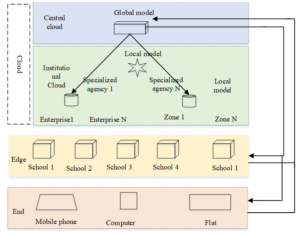
The general idea of technical logic
First, according to relevant national laws and regulations, after obtaining authorization and permission from data owners before data exchange, the central cloud (mainly referring to highly credible higher education institutions, research institutes, education authorities, etc.) sends the initial FL global model of students’ comprehensive literacy to specialized agencies (mainly referring to relevant government-owned institutions, such as the Education Technology and Resource Development Center of the Ministry of Education, the Secondly, each data owner uses their own data about students’ comprehensive literacy to train the FL model locally, and encrypts the model parameters and gradient information [17–18]. Then, the central cloud aggregates the model features trained by each data owner, such as updating the initial FL model of comprehensive student literacy using the federal average algorithm, and encrypting the aggregated model features to each data owner; finally, each data owner decrypts the aggregated model features received from the central cloud and uses the decryption Finally, each data owner decrypts the aggregated model features received from the central cloud and uses the decryption result to update the model locally for the next round of training. The above operations are repeated until the aggregated global model of students’ comprehensive literacy FL achieves a good fit in the central cloud.
FL technology logic at “cloud-cloud”, “cloud-end” and “cloud-edge” levels In the face of educational application scenarios, the development of federated learning is more likely to be carried out at the “cloud-cloud” level, which is not repeated in this section because the technical logic is the same as the general idea discussed above. In addition, under the guidance of the above general idea, there are also possibilities for FL at the “cloud-edge” and “cloud-end” levels, as described below. However, it should be noted that in the case of student I&E skills, due to the large amount of data and computing power required by the global model and the limited computing power deployed in schools, the application of FL at the “edge-end” level is not considered for the time being.
Based on the above discussion, this study is guided by the above technical logic and focuses on three types of implementation scenarios, as described below.
Study of students’ innovative and entrepreneurial learning literacy in horizontal FL
Students’ I&E learning can occur in multiple fields, such as schools, families, and science and technology venues, which correspondingly form in-school I&E learning data, family I&E learning data, and science and technology venues’ independent exploration data, however, due to commercial interests, data security and other reasons these data have certain difficulties in sharing, which affect the model construction [19]. In fact, Enterprise A (with in-school I&E learning data), Enterprise B (with home I&E learning data), and Science and Technology Museum (with independent exploration data) have different volumes of I&E learning data, and their student samples in different regions do not intersect, or even in the same region have little or no intersection. However, the data characterizing students’ I&E learning literacy are basically consistent in terms of feature dimensions, which means that there is a large overlap of data feature dimensions. Therefore, in this case, it is necessary to use the data of all student samples from Enterprise A, Enterprise B, and Science and Technology Museum with overlapping student I&E learning literacy data features as training data, as in Figure 6.
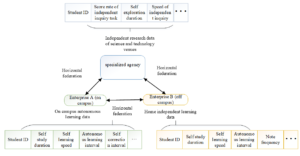
Figure 6: Example of learner autonomy based on horizontal FL Let \(\{ {D_A}\} ,\{ {D_B}\}\) denote the student sample sets of Enterprise A, Enterprise B, and Science and Technology Museum with overlapping student I&E learning literacy data features, respectively. The overall training process of the student I&E learning literacy evaluation model based on horizontal FL can be summarized as follows: first, Enterprise A, Enterprise B, and Science and Technology Museum download the initial student I&E learning literacy from the central cloud Second, each data owner independently calculates the model parameters (e.g., I&E learning duration, I&E learning speed, I&E learning interval, etc.) or model gradients locally with their respective student sample sets \(\{ {D_A}\} ,\{ {D_B}\}\)and encrypts the parameters or gradient information using encryption technology, and then sends them to the central cloud. Then, the central cloud can use algorithms such as weighted average (gradient average, model average) based on homomorphic encryption to securely aggregate the sent parameter or gradient information, update the student I&E learning literacy FL global model, and return the aggregated parameter or gradient information to each data owner in an encrypted manner; finally, each data owner decrypts the received new parameter or gradient information and Finally, each data owner decrypts the new parameters or gradient information received, and updates the local model with the decrypted parameters or gradient results to enter the next round of training, and so on until the loss function converges. The central cloud aggregates the parameter or gradient information of the last round of local computation and outputs the final student I&E learning literacy evaluation model for testing and validation.
A study of student physical health literacy in longitudinal FL
In the age of intelligence, it is often not enough to build a student physical health literacy evaluation model relying only on daily dietary and nutritional data from schools, but regular, official physical fitness monitoring data and even family exercise data are needed to jointly support the model construction [20]. Currently, these data are stored in schools, education technology companies, and education authorities, and have not been able to converge and share effectively. In the same region, the data of schools, education technology companies and education authorities have different data characteristics, but there is a certain intersection of the student samples they cover, i.e., there is a large overlap of student samples. Therefore, in this case, we need to use the overlapping student sample data from schools, education technology enterprises and education authorities as training data, and extend the data feature dimensions to all the feature fields covered in the tripartite database, and then carry out the construction of the student physical fitness and health literacy evaluation model based on longitudinal FL, as in Figure 7.
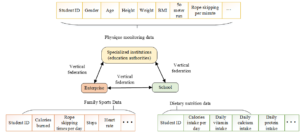
Figure 7: Example of students’ physical health literacy based on vertical FL Let \(\{ D,Lean\} \cup \{ D,enterprise\} \cup \{ D,teach\}\) denote the dataset of student samples overlapped by schools, education technology enterprises to education authorities, respectively, and \(\{ D,Lean\} \cup \{ D,enterprise\} \cup \{ D,teach\}\) denote the dataset with common students, the training process of student physical health literacy evaluation model based on longitudinal FL is generally divided into two parts. In the first part, student sample ID alignment is performed using encryption to obtain a dataset \(\{ D,Lean\} \cup \{ D,enterprise\} \cup \{ D,teach\}\) with common students covering all feature fields in the tripartite database. In the second part, each data owner locally uses the dataset \(\{ D,Lean\} \cup \{ D,enterprise\} \cup \{ D,teach\}\) to collaboratively train the FL global model of student physical health literacy. The specific steps are: first, the initial FL global model of student physical fitness and health literacy constructed by the central cloud is distributed to schools, education technology enterprises, and education authorities, and public keys are distributed to each of them; second, each data owner uses the dataset \(\{ D,Lean\} \cup \{ D,enterprise\} \cup \{ D,teach\}\) to train the encrypted model locally, and exchanges the intermediate calculation results between two by encryption to encrypt the calculation model parameters (e.g., number of jump ropes per minute, number of steps, daily protein intake, etc.) or gradient information; then, each data owner uploads the encrypted calculation results to the central cloud, which decrypts them and updates the global model of students’ physical fitness literacy FL; finally, the central cloud returns the decrypted calculation results and loss information to each data owner for updating their respective local models and entering the next round of training Finally, the central cloud returns the decrypted computational results and the loss information to each data owner, which is used to update their respective local models for the next training round. The model convergence is the same as above and is not repeated here.
A study of students’ mathematical literacy in federal transfer learning
When model building is carried out across institutions and regions, influenced by different institutions’ and regions’ model building capabilities, data volume, data labels, data silos, etc., and then achieve the purpose of jointly serving multiple parties. For example, there is a need to evaluate the mathematical literacy of students in region A (high level of educational informatization) and region B (low level of educational informatization), but in a realistic sense the raw data owned by the two regions cannot be exchanged and cannot be easily aggregated to the upper layer of research institutions, etc., plus the intersection of the data features existing in the two regions about students’ mathematical literacy is small (there is no intersection of student samples). Therefore, in this case, federal transfer learning can be carried out between the two regions to jointly construct a student mathematical literacy evaluation model using data from both sides and then carry out the evaluation, as in Figure 8.
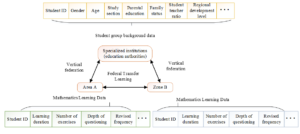
The idea of longitudinal FL between \(\{ D,region,A\} ,\{ D,region,B\}\) and the educational authorities is as described previously and will not be repeated here. Let \(\{ D,region,A\} ,\{ D,region,B\}\) denote the datasets of region A and region B about students’ mathematical literacy, respectively, and the federal migration learning process between region A and region B is as follows: first, region A and region B construct the initial student mathematical literacy evaluation models (here, the student mathematical literacy evaluation models obtained after the aforementioned longitudinal FL) using \(\{ D,region,A\} ,\{ D,region,B\}\), respectively, M number A, M number B; second, both parties send each other public secret keys and send the result information of their respective model calculations (e.g., learning hours, number of exercises, revision frequency, discussion frequency, etc.) to each other through encryption to exchange intermediate results; third, both parties calculate the received model feature information locally and send it to each other through encryption; fourth, both parties decrypt the result information and update the local model, and the cycle repeats, resulting in The model converges, and finally a high-performance student mathematical literacy evaluation model M number FEL is obtained.
C. Implementation plan of I&E education mode under the domain of “Internet+”
Cultivating the awareness of I&E and creating an atmosphere of I&E are important foundations of I&E education. Combining national policies, educational directions and social needs, we conduct I&E publicity and issue consultation in colleges and faculties, formulate specific I&E cultivation policies for the actual school, carry out diversified I&E activities, conduct I&E skills training to actively participate in I&E activities through various measures such as guidance, incentive and guarantee, and propose a set of measures to promote innovation We propose a set of effective practical programs to promote the cultivation of I&E, explore the potential of I&E, and create a strong atmosphere of I&E. We encourage and support students to start their own business in emerging industries and hot technology industries, and improve the rate of successful business and employment by taking results as the guide.
To improve students’ learning motivation, stimulate innovation consciousness, explore entrepreneurial potential, and cultivate students’ I&E practical ability as the main line, the I&E education curriculum is divided into three stages: I&E initiation course, I&E practical training course, and entrepreneurship project practical course. The first classroom education is integrated into the second classroom education, and the second classroom education is an effective supplement to the first classroom education. The course teaching arrangement emphasizes the integration of course knowledge, innovates course teaching methods and teaching methods, encourages students’ I&E learning, collaborative learning and ability demonstration, guides students to build diversified network learning communities and diversified I&E teams, integrates school-local cooperation into course teaching, and actively cultivates and motivates students. The specific I&E course education model is in Figure 9.

Cultivating students’ learning skills and I&E ability is an important content of university education under the perspective of “Internet+”. We focus on guiding students to combine I&E culture, technology, learning content and themselves, and realize a real learning-oriented talent cultivation path by updating concepts, teaching methods and learning ideas according to the cultivation program of forming I&E mindset, constructing knowledge system, improving I&E skills and supporting I&E team. In the I&E practical training to strengthen students’ professional skills improvement and entrepreneurial methods, encourage and help students to build a diversified network learning community, through which the network learning community can enable students to form virtual communities globally, providing a convenient platform for college students to improve their abilities and incubate I&E projects. In order to make the talent training and enterprise needs can be effectively docked, strengthen the practical teaching of the curriculum, with the common vision of “school and local co-creation, cooperation and win-win”, put forward feasible I&E solutions, explore effective I&E guarantee mechanism, set up a set of entrepreneurial guidance, entrepreneurial thinking orientation, entrepreneurial project incubation, entrepreneurial platform construction, entrepreneurial guarantee, service support, entrepreneurial project operation and management of talent training and industry-university-research combination strategy, and through the practical aspects of entrepreneurial projects to train hot skills, diversified and emerging industry talents.
4. Experiments
This experiment starts with a specific I&E project, from the concept of product design, a comprehensive analysis and summary of user requirements research, system requirements, functional requirements, performance requirements, etc.
5. Case Study
A. Demand investigation and analysis of the platform
Requirement Survey
Targeted interviews, questionnaires, demand survey analysis of development environment, system functionality and non-functionality were conducted.
Selected experts and excellent teachers from some universities in I&E education were interviewed. Focused on the experience of Internet+ competition, college students’ I&E training program project and the formation of teaching mode, analyzed the problems and difficulties, and finally formed the questionnaire.
Analysis of Questionnaire Data
Analysis of students’ participation in I&E projects and competitions in different grades
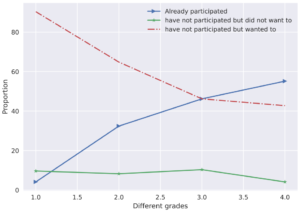
Figure 10: Chart of the situation and willingness of students of different grades to participate in I&E projects or competitions From the data chart in Figure 10, we can see that in the first year and the second year, I&E projects or competitions are rarely participated in, and the demand for participation is strong. The proportion of non-participation and unwillingness to participate is 88% and 64% respectively, increasing gradually from the first year to the fourth year. This is mainly due to the gradual opening of I&E student courses and the active promotion of competitions such as Internet+ I&E student courses and Challenge Cup. There are still 4-9% of students who are not interested in the projects and competitions of I&E students, so it is worth considering how to cultivate these I&E students.
Analysis of the main problems encountered by students in different grades in I&E projects or competitions
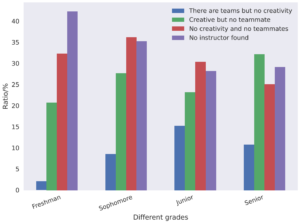
Figure 11: Main problems of different grades in I&E projects or competitions Through data analysis of Figure 11, the problems with a combined score of more than 30% mainly lie in one is wanting to research a problem but lacking professional knowledge (57%), two is not being able to find a mentor (36%), and three is having no creativity and not being able to find a suitable teammate (34%). This requires us to devote more attention to the curriculum construction, teacher and expert pool construction, creative case and resource library construction, team formation and project management when designing the I&E education platform.
Analysis of the demand degree of I&E education platform by students in different grades

Figure 12: Demand of students of different grades for I&E education platform Through the data in Figure 12 we can clearly find that more than 87% of students with a combined score think that establishing a platform with the functions of team formation, teaching, experience sharing, competition, information and incubation is helpful to the development of students’ own I&E education.
Analysis of all participating students’ recognition of the functional modules of the I&E education platform
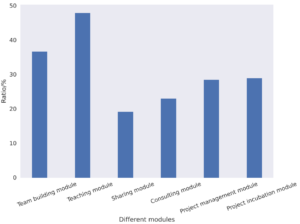
Figure 13: Diagram of comprehensive recognition of students in each module of the platform Through the analysis of the Figure 13, it can be verified again that in the process of platform design and development, it should focus on the construction efforts of teaching module, teaming module, project incubation and management module.
B. Analysis of platform development environment requirements
As a technical college students’ entrepreneurial team, the Studio has combined its technical advantages and campus network environment to analyze the requirements of platform development environment. The development environment of the online teaching platform for I&E education is in Table 1.
| Project | Implementation |
|---|---|
| System platform | Windows server |
| Application program | Program running environment: Apache |
| Application program | Program development language: PHP |
| Application program | Program development framework: Think PHP |
| Application program | Program style framework: Bootstrap |
| Database | My SQL |
C. Effective ways of I&E education
Integrate the concept of “Internet +” into students’ I&E education
With the advantage of technology, the Internet accommodates a wide range of information and knowledge and can build a standardized team of teachers, i.e., to promote the educational classroom in the form of network and establish an educational platform related to the Internet. Students in universities can choose different courses according to their majors and entrepreneurship direction, for example, students of management and other majors need I&E education, but students of literature are not in great demand.
Implementing practical training of I&E with “Internet+”
In implementing the I&E model in the era of “Internet +”, colleges must pay attention to the practical training because it is the key way for college students to master the I&E method and also an effective way to improve their I&E ability. In such a social background, the practical training courses carried out by universities should include two parts: non-course teaching practical training and course teaching practical training, and then establish corresponding education programs according to students’ own characteristics and career planning, i.e. “Internet + education” and “Internet + industry”. The program will be launched in the form of “Internet + Education”, “Internet + Industry”, etc.
Establishment of I&E practice platform
In establishing the I&E practice platform, universities can be divided into two parts, namely, practice and theory, which can be started from the following aspects. First, the theory platform. When building the theoretical platform, we created an information search function, in which the university uploads courses, materials, and information related to I&E to the platform, so that students who need it can quickly search for relevant information. The purpose is to encourage students who are interested in entrepreneurship to be more confident and work hard to build their own world.
Second, the practice platform. When setting up the practice platform, the function of practical training at a glance can be set up, so that universities can upload all kinds of practical training on entrepreneurship and innovation education to attract more students to join the platform. The university can also record and upload students’ practical training to the platform, so that students can learn and learn from it. By creating online registration function, we can put the information of various offline entrepreneurship competitions into the platform, which will bring more opportunities for students to exercise and improve the level of I&E education for college students.
Using school-enterprise cooperation to stimulate students’ innovation and entrepreneurial potential
Universities can choose to cooperate with local famous enterprises, which can not only promote education but also cultivate high quality and high technology comprehensive talents to meet the needs of talents for social development. In the process of actual cooperation, universities can make targeted education mode according to the feedback information from enterprises, which can not only realize oriented training, but also promote the effective combination of theory and practice. With the advent of the information age, some enterprises with traditional production models must transform to cultivate talents with “Internet+ I&E” capabilities to achieve development in conjunction with the information age. We will promote exchanges between schools and enterprises and improve students’ own innovative and entrepreneurial abilities by conducting expert lectures and establishing entrepreneurship funds.
6. Conclusion
To sum up, the current “Internet+” technology has brought opportunities and challenges to I&E students. Only colleges and students can seize the opportunity, combine reality, constantly improve the “Internet+ era”, and combine reality. Constantly improve the I&E education mechanism in the “Internet+” era to attract more college students to participate. Only by building high-quality I&E education can we fully stimulate students’ entrepreneurial enthusiasm and enthusiasm, provide positive and correct leadership. From the perspective of “Internet+”, the teaching reform of information technology courses for college students is an inevitable choice to adapt to the development of the times.
Funding
The Construction and Practice of Innovative and Entrepreneurial Practice Education Model in Higher Vocational Education: Taking the “Muxin Assisting Bathing” Double Creation Project as an Example(GZ222052). Construction and Practice of the Innovation and Entrepreneurship Education System of “Three Element Joint Forces and Three Step Progression” in Vocational Colleges (Z233154).
References
- Zhou J, Zhang D, Ren W, Zhang W. Auto color correction of underwater images utilizing depth information. IEEE Geoscience and Remote Sensing Letters. 2022 Apr 26;19:1-5.
- Vershitskaya ER, Mikhaylova AV, Gilmanshina SI, Dorozhkin EM, Epaneshnikov VV. Present-day management of universities in Russia: Prospects and challenges of e-learning. Education and Information Technologies. 2020 Jan;25:611-21.
- Glaeser EL, Hausman N. The spatial mismatch between innovation and joblessness. Innovation Policy and the Economy. 2020 Jan 1;20(1):233-99.
- Lv M, Zhang H, Georgescu P, Li T, Zhang B. Improving education for innovation and entrepreneurship in Chinese technical universities: A quest for building a sustainable framework. Sustainability. 2022 Jan 6;14(2):595.
- Chen WP, Lin YX, Ren ZY, Shen D. Exploration and practical research on teaching reforms of engineering practice center based on 3I‐CDIO‐OBE talent‐training mode. Computer applications in engineering education. 2021 Jan;29(1):114-29.
- Ma L, Lan Z, Tan R. Influencing factors of innovation and entrepreneurship education based on the theory of planned behavior. International Journal of Emerging Technologies in Learning (iJET). 2020 Jul 10;15(13):190-206.
- Hua S, Ren Z. “Online+ Offline” course teaching based on case teaching method: a case study of entrepreneurship education course. International Journal of Emerging Technologies in Learning (iJET). 2020 Jun 1;15(10):69-85.
- Huang Y, An L, Liu L, Zhuo Z, Wang P. Exploring factors link to teachers’ competencies in entrepreneurship education. Frontiers in Psychology. 2020 Nov 5;11:563381.
- Wood YI, Zegwaard KE, Fox-Turnbull W. Conventional, remote, virtual and simulated work-integrated learning: A meta-analysis of existing practice. International Journal of Work-Integrated Learning. 2020;21(4):331-54.
- Pandit D, Agrawal S. Exploring challenges of online education in COVID times. FIIB Business Review. 2022 Sep;11(3):263-70.
- Ling Y, Chung SJ, Wang L. Research on the reform of management system of higher vocational education in China based on personality standard. Current Psychology. 2023 Jan;42(2):1225-37.
- Sepasgozar SM. Digital twin and web-based virtual gaming technologies for online education: A case of construction management and engineering. Applied Sciences. 2020 Jul 7;10(13):4678.
- Yao S, Li D, Yohannes A, Song H. Exploration for network distance teaching and resource sharing system for higher education in epidemic situation of COVID-19. Procedia Computer Science. 2021 Jan 1;183:807-13.
- González-Pérez LI, Ramírez-Montoya MS. Components of Education 4.0 in 21st century skills frameworks: systematic review. Sustainability. 2022 Jan 27;14(3):1493.
- Kumar A, Krishnamurthi R, Bhatia S, Kaushik K, Ahuja NJ, Nayyar A, Masud M. Blended learning tools and practices: A comprehensive analysis. Ieee Access. 2021 Jun 3;9:85151-97.
- Portuguez Castro M, Gomez Zermeno MG. Challenge based learning: Innovative pedagogy for sustainability through e-learning in higher education. Sustainability. 2020 May 15;12(10):4063.
- Guàrdia L, Clougher D, Anderson T, Maina M. IDEAS for transforming higher education: an overview of ongoing trends and challenges. International Review of Research in Open and Distributed Learning. 2021 May;22(2):166-84.
- Hadgraft RG, Kolmos A. Emerging learning environments in engineering education. Australasian Journal of Engineering Education. 2020 Jan 2;25(1):3-16.
- Bodolica V, Spraggon M. Incubating innovation in university settings: building entrepreneurial mindsets in the future generation of innovative emerging market leaders. Education+ Training. 2021 May 17;63(4):613-31.
- Kidd W, Murray J. The Covid-19 pandemic and its effects on teacher education in England: how teacher educators moved practicum learning online. European Journal of Teacher Education. 2020 Aug 7;43(4):542-58.